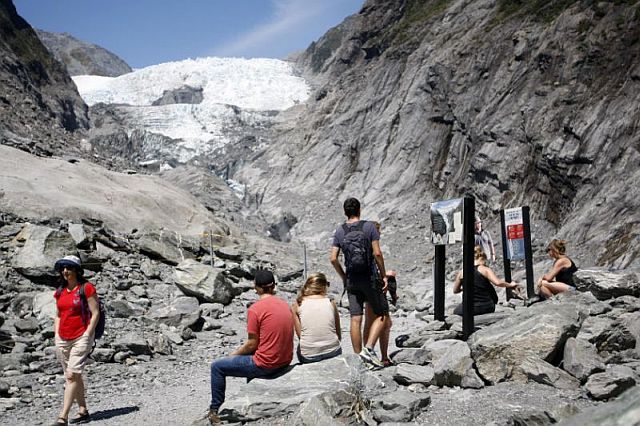
Tourists relax at the end of a track at the Franz Josef Glacier in New Zealand in this Feb. 6, 2016 photo.
WELLINGTON, New Zealand — Ski fields are struggling to open and winter electricity consumption is down in New Zealand after the first six months of 2016 proved to be the hottest start to a year that scientists have ever recorded.
Temperatures in the South Pacific nation were 1.4 degrees Celsius above the long-term average for the first half of the year, according to the government-funded National Institute of Water and Atmospheric Research.
That’s the highest since record-keeping began more than a century ago, and significantly higher than the previous record of 1.1 Celsius above average, reached in 1938 and again in 1999.
Chris Brandolino, a scientist at the research agency, said Monday that ocean temperatures in the Tasman Sea to the west of New Zealand have been unusually warm this year and that warmer winds from the north have also predominated.
“What’s happened in the background is that the Earth has continued to warm as greenhouse gas levels have risen,” he said.
The agency reported that carbon dioxide levels recorded at a station near Wellington passed 400 parts per million in June for the first time. The threshold is seen as significant internationally as an indicator of climate change.
While many New Zealanders reveled in a summer that never seemed to end, commercial ski fields including Coronet Peak, Mount Hutt and Turoa have found themselves with little snow, electing to delay opening or operating with limited runs as the Southern Hemisphere winter gets underway.
Brandolino said the rise in average temperatures doesn’t necessarily mean the ski season will be bad, “although if I’m a skier or snow enthusiast, record warm temperatures aren’t going to bode well for me.”
Disclaimer: The comments uploaded on this site do not necessarily represent or reflect the views of management and owner of Cebudailynews. We reserve the right to exclude comments that we deem to be inconsistent with our editorial standards.
